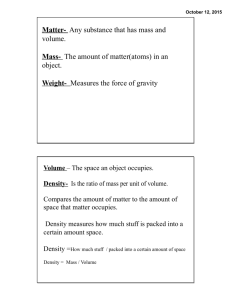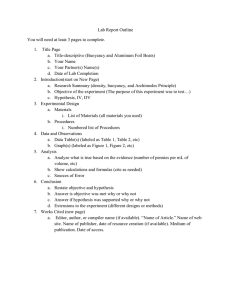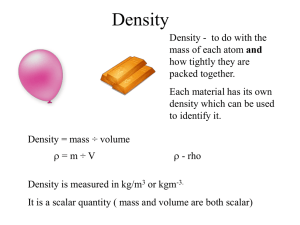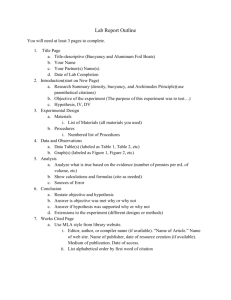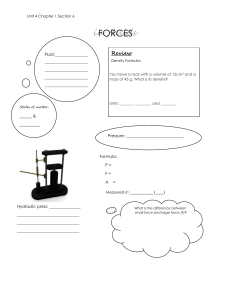Hydrotherapy: Principles & Applications
advertisement
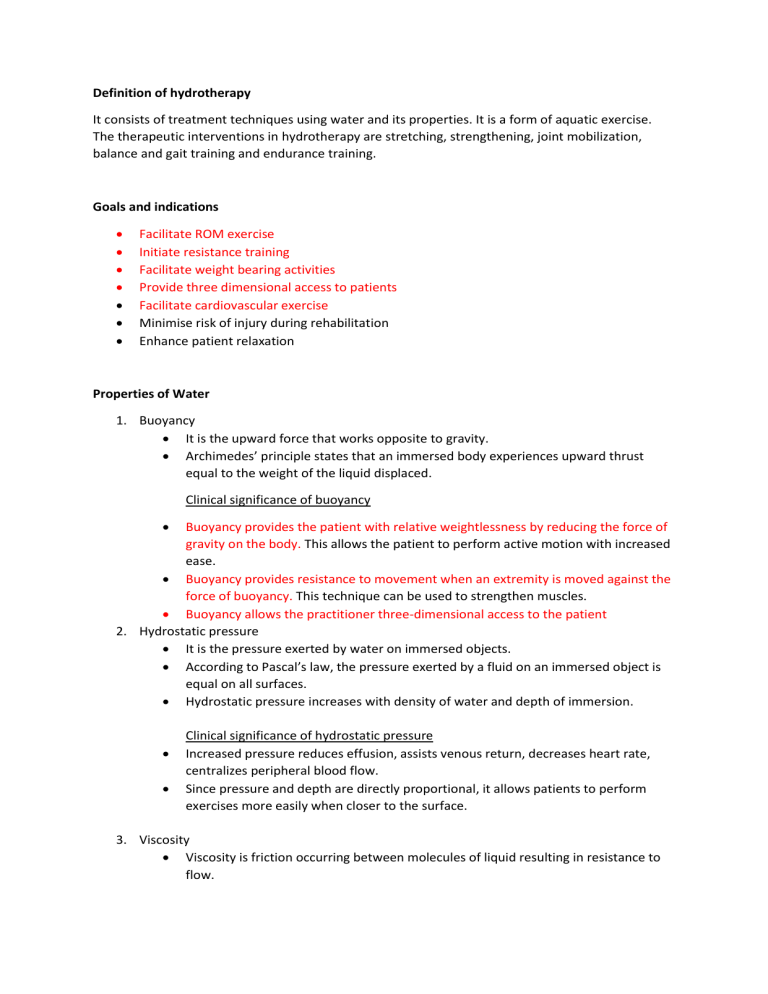
Definition of hydrotherapy It consists of treatment techniques using water and its properties. It is a form of aquatic exercise. The therapeutic interventions in hydrotherapy are stretching, strengthening, joint mobilization, balance and gait training and endurance training. Goals and indications Facilitate ROM exercise Initiate resistance training Facilitate weight bearing activities Provide three dimensional access to patients Facilitate cardiovascular exercise Minimise risk of injury during rehabilitation Enhance patient relaxation Properties of Water 1. Buoyancy It is the upward force that works opposite to gravity. Archimedes’ principle states that an immersed body experiences upward thrust equal to the weight of the liquid displaced. Clinical significance of buoyancy Buoyancy provides the patient with relative weightlessness by reducing the force of gravity on the body. This allows the patient to perform active motion with increased ease. Buoyancy provides resistance to movement when an extremity is moved against the force of buoyancy. This technique can be used to strengthen muscles. Buoyancy allows the practitioner three-dimensional access to the patient 2. Hydrostatic pressure It is the pressure exerted by water on immersed objects. According to Pascal’s law, the pressure exerted by a fluid on an immersed object is equal on all surfaces. Hydrostatic pressure increases with density of water and depth of immersion. Clinical significance of hydrostatic pressure Increased pressure reduces effusion, assists venous return, decreases heart rate, centralizes peripheral blood flow. Since pressure and depth are directly proportional, it allows patients to perform exercises more easily when closer to the surface. 3. Viscosity Viscosity is friction occurring between molecules of liquid resulting in resistance to flow. Resistance from viscosity is proportional to the velocity of movement through liquid. Clinical significance of viscosity Viscosity creates resistance with all active movements. Increasing the velocity of movement increases the resistance. Increasing the surface area moving through water increases resistance. 4. Surface tension Surface tension is the property of the surface of a liquid that allows it to resist an external force. Surface tension is measured as force per unit length. Surface tension is proportional to the size of the object. Clinical significance of surface tension An extremity that moves through the surface performs more work than if kept under water. Using equipment at the surface of the water increases the resistance. Hydromechanics Hydromechanics comprises the physical properties and characteristics of fluid in motion. Components of flow motion Three factors affect flow; they are laminar flow, turbulent flow, and drag. Laminar flow - Movement in which all molecules move parallel to each other, typically slow movement. Turbulent flow - Movement in which molecules do not move parallel to each other, typically faster movements. Drag - The cumulative effects of turbulence and fluid viscosity acting on an object in motion. Clinical significance of drag As the speed of movement through water increases, resistance to motion increases. Application of equipment (glove/paddle/boot) increases drag and resistance. Centre of buoyancy The centre of buoyancy is the point on an immersed object on which buoyant (vertical) forces of fluid act. Clinical significance of centre of buoyancy In the vertical position, the human centre of buoyancy is located at the sternum. In the vertical position, posteriorly placed buoyancy devices cause the patient to lean forward; anterior buoyancy causes the patient to lean back. Patients bearing weight on the floor of the pool (i.e., sitting, kneeling, standing) experience aspects of both the centre of buoyancy and centre of gravity. Aquatic temperature 26-33 deg C is used for flexibility, strengthening, gait training, relaxation 33 deg C used for painful musculoskeletal conditions 26-28 deg C is used for cardiovascular training 22-26 deg C is used for high intensity exercises Precautions Fear of water = This can limit effectiveness of any immersed activity. Neurological disorders = Patients with neurological disorders like epilepsy must be closely monitored during treatment. Cardiac dysfunctions = Patients with angina, abnormal bp, heart disease must be closely monitored during treatment. Open wounds = open wounds and tracheostomies must be covered with waterproof dressings before treatment. Respiratory disorders = Water immersion may adversely affect breathing of patients with respiratory disorders. Lung expansion may be inhibited by hydrostatic pressure against chest wall. Contraindications Cardiac failure and unstable angina Respiratory dysfunction, vital capacity less than 1 litre Severe peripheral vascular disease Danger of bleeding or hemorrhage Severe kidney disease Open wounds, skin infections Uncontrolled bowel or bladder Water and airborne infections or diseases like typhoid, cholera, GIT infection Uncontrolled seizures Equipments used for hydrotherapy The rooms in which pools are housed need to be adequately ventilated to avoid the accumulation of condensation on walls, windows, and floors. A dressing room should be provided for changing clothes and showering. 1. Whirlpool A whirlpool may be used to improve circulation, mobility, and comfort after an injury or after surgery Used only for extremities. Useful to treat painful conditions, assisted exercises, mobilization. 2. Hubbard tank Stainless steel tank that has the shape of a key hole. Tank designed for full immersion of the body A narrow section at the middle of the tank allows the therapist to reach the patient, and wider sections at each end permit full abduction of the patient's legs and arms. The Hubbard tank is useful in the treatment of patients with extensive burns and those with chronic multiple joint disorders. 3. Outdoor pools Suitable for all types of aquatic exercise Dressing cubicles, waiting rooms, heated cupboards or drying area provided Doorways are wide enough for wheelchairs and stretchers to pass Entrance to larger therapeutic pools includes ramps, stairs, ladders, or mechanical overhead lifts. These pools have built-in chlorination and filtration systems They have parallel bars of adjustable height and width Submerged bench or seat Special equipment for aquatic exercise Aquatic equipment is used to provide buoyancy and resistance to movement. Cervical collars Floatation rings Belts, vests Dumbbells Gloves, paddles Fins, boots Kickboards Support neck in supine position and keep head out of water Support extremities in immersed position For buoyancy and support patients in supine, prone or vertically Support upper body or trunk in upright positions Support lower extremities in supine or prone positions Provide resistance to upper extremity movements Provide resistance to lower extremity movements Provide buoyancy in supine or prone positions Create resistance to walking in shallow water when held vertically For balance training in water
